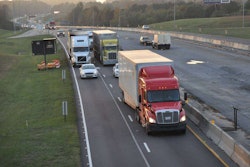Earlier this year, the U.S. Department of Transportation called on various transportation industries, including trucking, to provide information about ongoing supply chain disruptions for a report to be submitted to President Joe Biden.
More than 400 comments were submitted between Sept. 16 through Oct. 18. Under an executive order issued by Biden in February, DOT Secretary Pete Buttigieg is required to submit, within a year of the order, a report to the President on supply chains for the transportation industrial base. Comments received on this information request will be used in that report.
Trucking groups including the Owner-Operator Independent Drivers Association, National Association of Small Trucking Companies, American Trucking Associations and others submitted their comments to answer a number of questions posed by DOT in the information request.
Trucking groups focused on many of the topics that are often brought up as issues in the industry that impede the movement of freight, including detention time, insufficient truck parking facilities, infrastructure investment, independent contractor status issues and more.
“While global supply shortages have recently forced some truckers off the road due to regulatory processing delays and difficulties finding replacement parts for faulty equipment, the current crisis is not due to a shortage of truck drivers,” OOIDA said in its comments. “Because the real bottlenecks in the supply chain occur at pickup and delivery points, adding more trucks and drivers will simply make lines longer, not faster.”
The group added that DOT should prioritize “resolving the underlying circumstances that have led to excessive driver turnover. We support the administration’s efforts to improve the quality of trucking jobs, but this must start with treating drivers as essential workers which means valuing and compensating them for all of their time.”
[Related: Who's really to blame for the ports issues?]
Infrastructure investment
OOIDA and ATA were among commenters to note the lost productivity in trucking due to highway congestion, which costs trucking nearly $75 billion and more than a billion hours of lost productivity annually.
“Congestion serves as a brake on economic growth and job creation nationwide,” ATA said. “A first-world economy cannot survive a third-world infrastructure system. As such, the federal government has a Constitutional responsibility to ensure that the resources are available to address this self-imposed and completely solvable situation.”
The two groups also specified the shortage of truck parking as a barrier to supply chain efficiency. ATA noted that time spent looking for parking costs individual truck drivers about $5,500 in direct compensation annually, with an average 56 minutes per day given up if they choose to park early rather than risking not finding parking farther down the road.
OOIDA said parking challenges make it more difficult for drivers to rest when they are tired and comply with hours of service regulations, while often forcing drivers to park in unsafe locations.
[Related: Intermodal haulers fight off a 'system collapse' at ports]
Sleeper-berth flexibility
NASTC and the Truckload Carriers Association each called on DOT to provide more sleeper-berth options in the hours of service regulations to allow drivers to better utilize their time. Overdrive's past surveying of its owner-operator readers has consistently showed this to be a high-priority ask of many owner-operators themselves when considering potential changes to the hours of service.
FMCSA heard those calls in recent years, to an extent, and just last year modified the sleeper berth split regs, allowing for a 7/3-hour split and new stop-the-duty-clock mechanisms within the shorter of the two periods. TCA said that modification "simply does not go far enough not only to increase productivity but also to improve safety performance and reduce exposure,” TCA said. “Providing drivers with the flexibility to take their rest in the sleeper berth at the interval that works best for them would greatly help alleviate the stress of crowded roadways and lost efficiency in driving times. Fewer trucks on the road during rush hour presents a commonsense goal for the regulatory community.”
[Related: Where to find a 2/3-hour 14-clock pause in the new hours of service regs]
NASTC said FMCSA should gather additional data on 5/5 and 6/4 splits to examine the “real-world effects of a broader array of split sleeper berth rest. We believe allowing truckers additional options for sleeper-berth time-splitting would contribute to improving the efficiency, safety, and reliability of moving goods.”
Independent contractor status
Several groups, including OOIDA, ATA, NASTC and TCA, voiced concern about state and federal legislation in play to more narrowly define conditions for independent contractors, such as California’s A.B. 5 (currently awaiting a petition against it to the Supreme Court) and introduced union-friendly legislation known as the PRO Act.
“One of the more disruptive developments that jeopardizes supply chain reliability and the safe, efficient movement of goods arises from the uncertain status of independent contractors in trucking and transportation,” NASTC commented. “The state of California bears much of the blame for this threat due to its A.B. 5 state law, which is currently tied up in litigation. This casts long shadows upon the long-haul trucking workforce, good-paying jobs, and the fulfillment of current and future needs and opportunities. Further, the Protecting the Right to Organize (PRO) Act’s Section 101(b) would essentially federalize the California A.B. 5 law’s ‘ABC test’ for worker classification.”
[Related: Owner-operators' big advocacy role out West against A.B. 5]
NASTC also urged the Department of Labor to consider reinstituting the Trump-era independent contractor rule that was withdrawn when the Biden administration took office. The rule would have defined independent contractor within the Fair Labor Standards Act using five economic-reality factors to make determinations as to whether a worker is an employee or an independent contractor. Two of those factors – the nature and degree of the worker’s control over the work and the worker’s opportunity for profit or loss – would have been the two “core” factors for determining a worker’s classification, carrying greater weight than the other three factors.
“Current barriers that inhibit supply chain performance most definitely include California’s A.B. 5 law, the terrible uncertainty surrounding that law, and the prospective nationalization of that highly disruptive law if Congress enacted the PRO Act,” NASTC added.
TCA called the ABC test “potentially one of the greatest threats to trucking’s ability to move freight across the county.. ... On top of the driver departure likely to be caused by a vaccine mandate, any threat to a driver’s ability to be in business for him- or herself and operate as an independent contractor, not an employee driver, will significantly hamper the trucking industry and our work on behalf of the American public,” the group said.
[Related: California A.B. 5: Unanswered questions, wait-and-see mode prevail out West]










